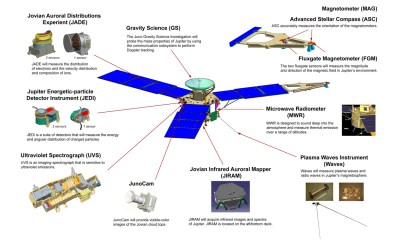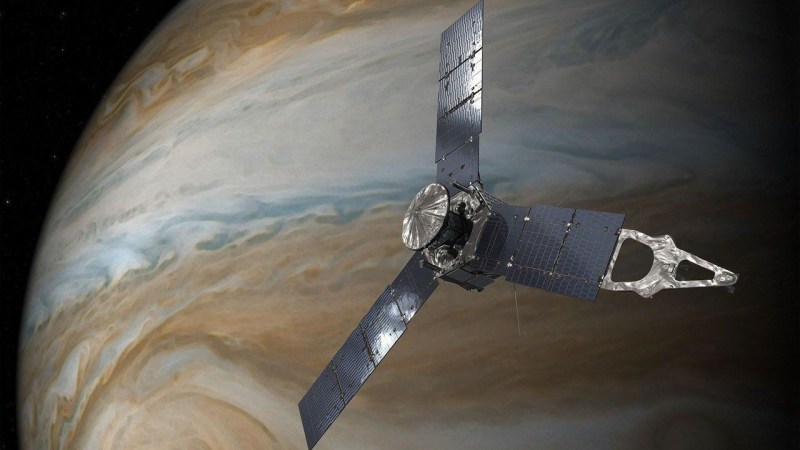The Juno spacecraft was launched towards Jupiter in August of 2011 as part of the New Frontiers series of spacecraft, on what would originally have been a 7-year mission, including a nearly 5 year cruise to the planet. After a mission extension, it’s currently orbiting Jupiter, allowing for many more years of scientific data to be gathered using its instruments. One of these instruments is the JunoCam (JCM), a visible light camera and telescope. Unfortunately the harsh radiation environment around Jupiter had led many to believe that this camera would fail before long. Now it seems that NASA engineers have successfully tested a fix.

Although the radiation damage to JCM was obvious a few dozen orbits in – and well past its original mission’s 34 orbits – the big question was exactly what was being damaged by the radiation, and whether something could be done to circumvent or fix it. The good news was that the image sensor itself was fine, but one of the voltage regulators in JCM’s power supply was having a bad time. This led the engineers to try annealing the affected part by cranking up one of the JCM’s heaters to a balmy 25°C, well above what it normally is kept at.
This desperate step seemed to work, with massively improved image quality on the following orbits, but soon the images began to degrade again. Before an approach to Jupiter’s moon Io, the engineers thus tried it again but this time cranked the JCM’s heater up to eleven and crossed their fingers. Surprisingly this fixed the issue over the course of a week, until the JCM seems as good as new. Now the engineers are trying their luck with Juno‘s other instruments as well, with it potentially providing a blueprint for extending the life of spacecraft in general.
Thanks to [Mark Stevens] for the tip.















Just heard a lovely presentation on this topic last week at NSREC and the statement really undersells what an amazing hack this all was.
IIRC JunoCam was technically a “late addition” to the Juno mission and was added for public outreach purposes. That mean that the team in San Diego didn’t have time to design a system from from scratch that could handle the harsh Jovian rad environment, so they reused a lot of existing hardware from the Mars Curiosity Rover (IIRC). So that’s amazing Hack #1
Amazing Hack #2 is that they realized that it was taking longer and longer for JunoCam to power up on every orbit, eventually taking multiple days to receive any telemetry from the camera. So they were like “can we pls not turn this off ever again until we figure out what is going on?”
There was a single temperature sensor on the JCM so they took to building thermal models back on earth to try to figure out what temperatures they would need to attempt annealing and the like.
Long story long, I believe they identified an unseen/overlooked SEFI in one of the voltage regulators that power the JCM. I think the current game plan is to continue to anneal at continuously higher temperatures, but this trick will only last so long as eventually TID effects will outpace the restorative annealing process.
(This is all from memory so I do not claim the authenticity of these statements…)
interesting info. now please expand sefi and tid?
SEFI is single event functional interrupt. “Something hit us and we stopped working.”
TID is total irradiated dose: how much radiation the device has been exposed to in total.
Courtesy of Google:
A Single Event Functional Interrupt (SEFI) is a non-destructive interruption in a device’s functionality caused by a single, high-energy particle strike, according to NASA Electronic Parts and Packaging (.gov). It can cause a component to reset, hang, or enter an unexpected operating condition without causing permanent damage. Unlike a single event latch-up (SEL) or single event burnout (SEB), a SEFI does not require power cycling to restore the device to its normal operation.
Total Ionizing Dose (TID) is the cumulative damage to the semiconductor lattice caused by exposure to ionizing radiation over time.
Google’s pulling stuff from JESD89A, I think, so it’s not that intuitive wording out of context – it’s not saying “you don’t need to power cycle to fix this” it’s saying “it’s possible that you could fix this without power cycling” although power cycling might be required depending on the way the instrument is designed if the SEFI was not anticipated or missed (or sometimes if it’s just the most expedient method). They’re logic failures due to a single-event upset (SEU), not hardware failures.
This is as opposed to SEBs/SELs, which are hardware failures, and will require power cycling to recover, if it is even possible (which for SEBs is usually ‘it’s not’).
The other comments got it mostly correct.
SEFI – Single Event Functional Interrupt is somewhat of a catch all term that describes any abrupt system failures caused by radiation. This could be something like a CPU becoming unresponsive while executing a program, the inability to read or write to memory, null pointer exceptions, etc. It typically refers to radiation effects in the context of larger “systems” (Circuits, FPGA/CPU-Memory interfaces, SoCs) as opposed to singular active devices (mosfets, op-amps, BJTs). For the most part, SEFIs can also be cleared with a power cycle, but not always. For singular devices, terms like Single Event Transient (SET) and Single Event Upset (SEU) are more commonly talked about.
TID – total ionizing dose is effectively how much ionizing radiation a device is subjected to. Within LEO this is typically dominated by protons but further out you’ve got to deal with Heavy Ions and cosmic rays. Basically any charged particle that is whizzing through space. In transistors (mosfets at least) the longer you spend in space the more TID you get and it manifests as a reduction in threshold voltage. The effects can be subtle and complicated but essentially the charged particles cause ionization in the semi conductor and because of the mismatch in mobility between holes and electrons, you end up turning your n-type more and more into p-types over time.
TID can also create displacement damage which will create charge carrier recombitation centers. Literally defects in the crystal lattice. Annealing at high temperatures helps to “heal” those defects which is what we see in JunoCam
I was wondering why they suggested 25℃ was so hot, but Mars is -55℃ on a hot day I think right? So if you use stuff that is designed for that then that’s quite a delta.
should be a ‘what’ in there somewhere.
Otherwise interesting bit of news I’d not heard yet.
I wonder what this did to the power budget? Did any other measurements need to be sacrificed even if only temporarily? Amazing work, but there’s no mention of any tradeoffs made to acheive it. I suppose there could be enough excess power available, but given how carefully they plan these things I’d be surprised.
Maybe I’m ignorant of the use case, but I’m used to seeing the word “annealing” being used in the context of working with metals, and it requires (in all cases with which I’m familiar) temperatures much higher than 25C.
Would someone kindly enlighten me about what is meant by “annealing” in this case?
Annealing just means heating something up and letting it cool down to rearrange the material’s lattice arrangement. With silicon ICs this actually happens at surprisingly reasonable temperatures.
Silicon photomultipliers for instance show significant recovery from radiation damage with temperatures between like 30-50 C. Considering they’re normally operated cold (to reduce noise), the plan in a lot of space-based observatories is to use Peltier cooling and periodically flip the direction for annealing.
Thanks!
:)
There is a non-zero chance that the engineers thought to do this because they had an Xbox 360.
I’m so curious, please elaborate on this
100% a hack. Nice work NASA. Wouldn’t it be great if more ‘Hail Marys’ like that paid off here on earth :p